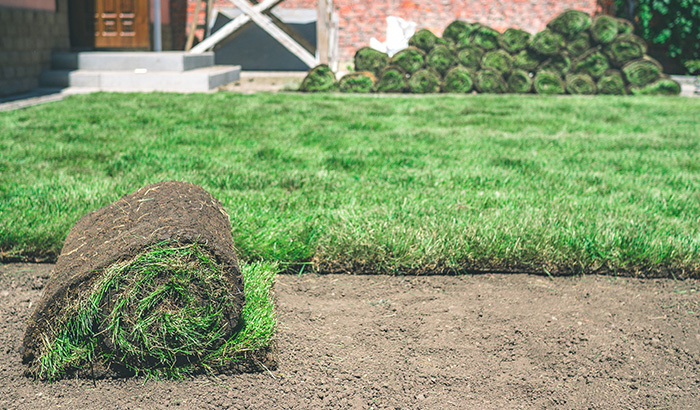Growing sod is a delicate process, so if you are brave enough to grow your own, be sure you get the timing right to end up with a beautiful lawn.
The right time to start growing your sod depends on your climate, the variety of seeds you choose, and where you’re growing it. Once you have your seeds in the dirt, it will take consistent care for two to four weeks to germinate them. Finally, your new grass will need several months to grow before they are ready for traffic.
To give a more in-depth answer, let’s discuss what factors affect the timeline for growing sod. Then, we’ll outline the process from seed to fully grown sod.
Factors for Your Sod Growing Timeline
Your Choice of Grass Seeds
There are a good variety of grasses you might choose that have different attributes. Kentucky Bluegrass, for example, is a solid, hardy variety that can take cold winters and hot summer weather. This makes it very popular for moderate and colder climates.
Other hybrids are optimized for drought resistance, low light conditions, high traffic tolerance, etc. You can sometimes combine the attributes you’re looking for by mixing different seeds. We recommend talking to a local horticulturist to learn what varieties work best in your area.
Why does the seed type matter to the timeline? Because different varieties take different amounts of time to germinate and grow. And if you get a colder hardy variety, it will be better able to withstand the winter at an earlier stage.
Your Climate
Colder climates generally have a shorter growing season, so your grass seedlings will have a smaller window to grab a foothold before winter. This doesn’t mean growing sod is impossible in colder climates.
You just need to first: use grass seeds that are compatible with your climate, and second, plan well, including watching the weather forecast before you commit to a planting date.
Your Growing Setup
Hopefully, it’s pretty evident that if you have access to a greenhouse or other climate-controlled, protected area, you can take all the time you like to grow your sod. But most people don’t have access to that type of enclosure, at least not one big enough to raise sod for an average-sized yard.
The next best thing is to have an enclosed yard where you can ensure your seeds won’t get trampled by kids or pets for an extended period. And by extended period, we mean six months to a year. If you are determined to grow your own sod, this is non-negotiable. Seeds need time to mature before they should be walked on.
The Process of Growing Sod
Before you start growing your own sod, you should know it’s a painstaking process. And that’s after you install the sprinklers. You’ll need to be very consistent about how you care for and protect your lawn for several months. If you can commit to that, there’s no reason you shouldn’t be successful. Here’s a step-by-step timeline for you to follow:
Prepping the Soil
Once you’ve determined the best time to start planting – generally, after the risk of frost is gone, it’s time to get your soil ready. If you’re replanting sod in ground that was formally planted with grass, there won’t be much needed here. Although, we do recommend going through and tilling, as well as removing weeds, rocks, etc.
If you’re planting in new ground, you’ll have more work. Start by tilling the soil, then raking to remove rocks and weeds. You may need to repeat these steps a few times until you’re confident you’re left with smooth soil. Then level and grade it as required.
If your soil has a lot of clay or it lacks nutrients, you will need to amend it. You can start by taking a sample to your local garden center for testing. They should be able to recommend the right amendments to get it ready for planting. Plan on giving yourself a week or so to get this part right before putting seeds in the ground.
Planting
When the time is right to plant, give yourself most of a day to do it. To start with, you’ll want to use enough seeds to cover the ground evenly – 10 to 20 lbs per 1,000 square feet is about right. Grass seed is relatively inexpensive, so use plenty.
You’ll want to add a few more amendments along with the seeds. Again, you should talk to your local garden center about what amendments to use with your seed, but we recommend something to add nutrients like Milorganite or Scotts Turf Builder Starter Food for New Grass. You can also buy grass seed that is already mixed with fertilizer.
Peatmoss adds nutrients and breaks up dense soil, allowing the seeds to breathe. It also provides some cover for the seeds to ensure they have enough contact with the soil to germinate.
Finally, if your ground is not entirely flat, there’s a chance your seeds could be washed away by watering, rain, and wind. Scotts PatchMaster is sticky and effective at keeping seeds in place long enough to take root. Once you get the seeds and all the amendments down, mix them up with a rake and water them.
Germination
Once you get the seeds in the ground, you need to provide good conditions for germination. Different seeds take different amounts of time to germinate, but it usually falls between two and four weeks.
The main thing you need to do to support germination is to ensure the seeds stay wet. Depending on the weather, this could take an hour a day under the sprinkler. If it’s really hot and dry, two hours split up may be necessary. Either way, it’s essential to be consistent with this.
Growing
Once your grass is growing, you’re well on your way to a nice lawn. But it’s still not ready for playing on. It may take five to 10 months for the roots to grow deep enough to withstand a lot of stress. The best thing you can do for your lawn during this time is to keep watering it consistently and keep people and pets off it. During the winter, the visible parts will turn brown, but the roots will continue to develop.
Monarch Sod Can Do the Hard Part for You.
If circumstances allow you to protect your lawn for several months, we wish you the best in growing sod yourself. We understand the satisfaction of literally watching grass grow.
But, if you prefer the convenience of having rolls of already-grown, healthy grass being delivered to your home, we’re here for you. We grow our grass in Lehi, UT. We’re pleased to serve Utah and Salt Lake Counties and the surrounding area. Contact us today to find out more.
var /*99586587347*/ toto slot










